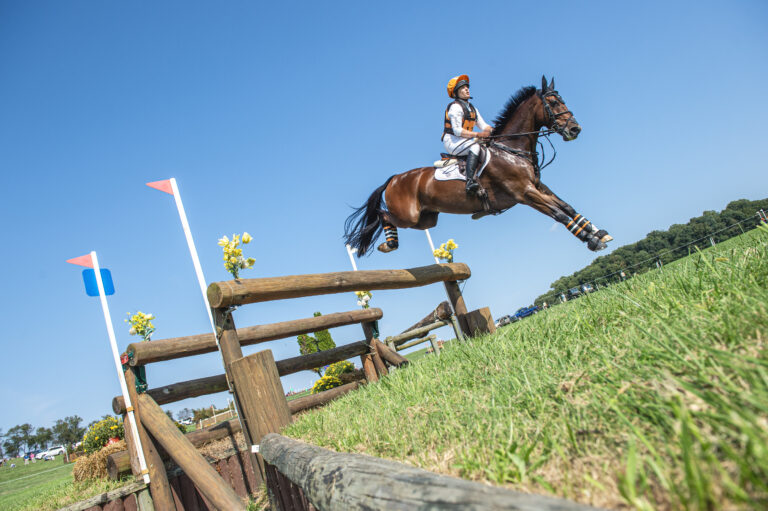Along with earning a spot on the 2020 Olympic eventing team, Liz Halliday has a resume that includes high-level car racing. During an informal mid-summer clinic in California, that part of her life emerged with her emphasis on developing, maintaining and shifting between the right gears for the horse in all three eventing phases.
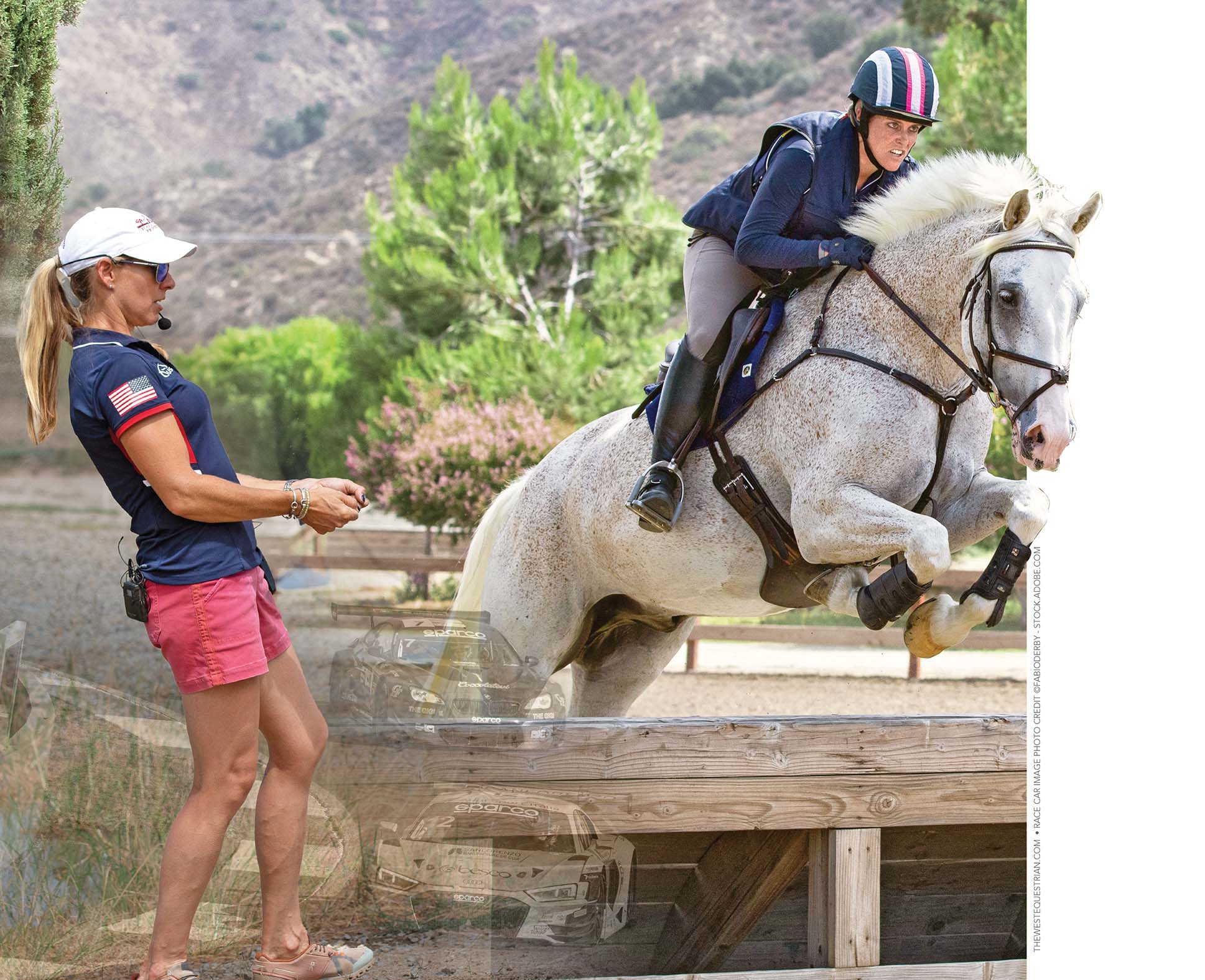
Speed is never the ultimate goal in any gear, she emphasized. For eventing, it’s all about power. “Speed does not equal power,” she counseled professional and amateur riders on horses that ranged from green youngsters to more seasoned campaigners.
Halliday’s partner in earning a Tokyo berth, Deniro Z, sustained a mild injury just before Team USA left for final Olympic preparation in late June. Instead, Halliday, based in Kentucky and Ocala, visited family in Southern California and offered a few lessons at Galway Downs Equestrian Center in Temecula.
Halliday explained to students that the right gears are found with the horse balanced between a steady, adjustable contact through the mouth and a “hugging” leg. This leg is firm at the horse’s side and poised to apply more pressure when the situation warranted. Equally essential in stadium jumping and on cross-country is an upright body position supported by a strong core.
With young horses in particular, creating the gears starts with developing strength. It also comes from training the horse in a way that helps him understand where his body parts are in space and how to use them.
Build Power with Transitions
Transitions were the name of the game for Elsie Patterson and her 5-year-old, Finnigan R-E, as they schooled dressage with Halliday to start the day. The gray KWPN has gone Beginner Novice with Patterson, a professional who hopes to move him up to Training by the end of the year.
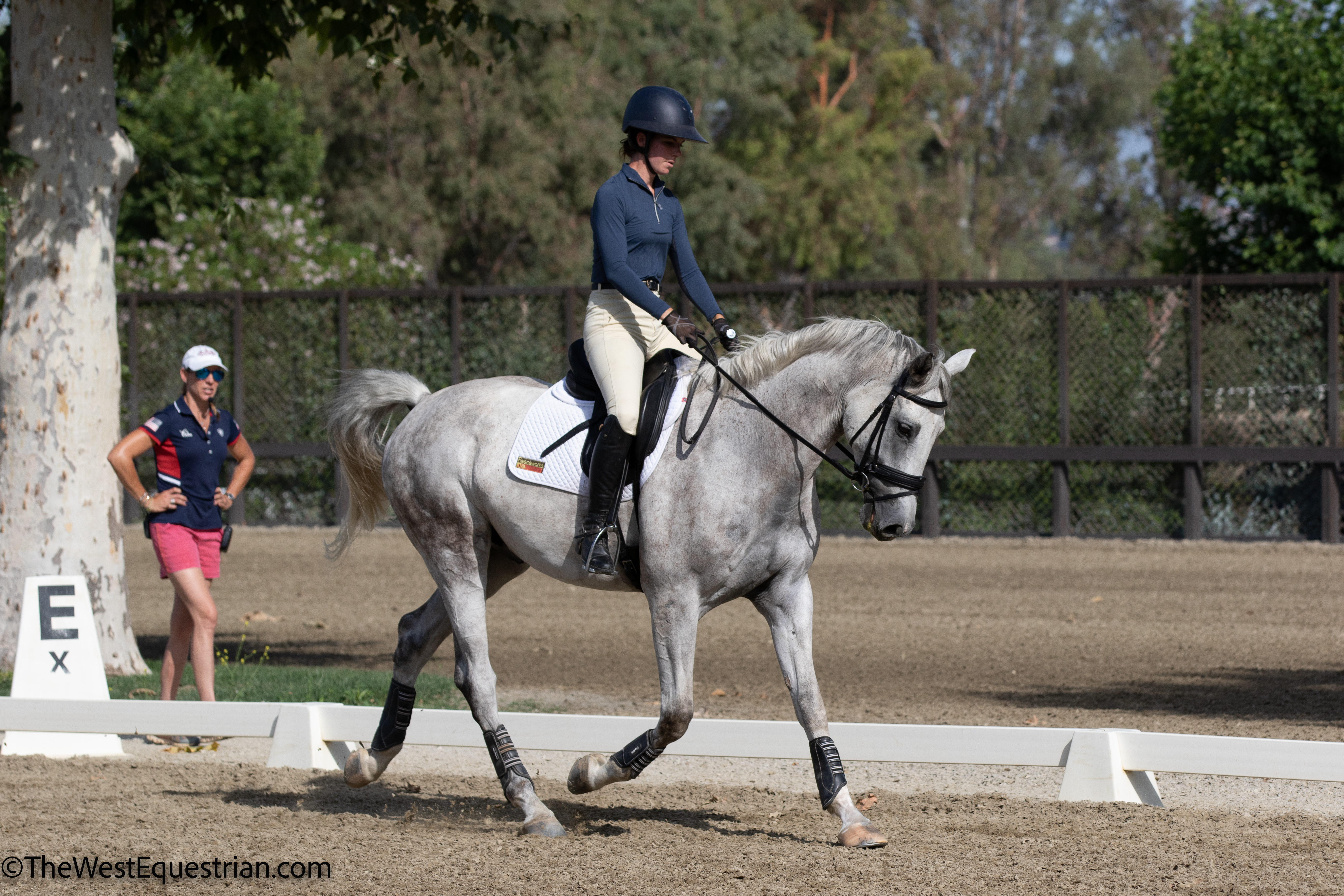
Developing more power through constant engagement, bending and bringing his hind legs up and underneath him were focuses.
Because of Finn’s tendency to root down, Halliday recommended reins with stoppers to make it easier to maintain a constant, relatively short rein length that also was adjustable. This rein contact is simultaneous with steady, firm leg pressure to communicate that “leg means to lift up” his front end.
Lifting the horse’s front end requires power in the hind end, and transitions are Halliday’s favorite exercise for building that. Especially when done on a circle—mostly 20-meter or 15-meter circles with Finn—the horse learns to bring his inside hind leg up underneath as the primary engine of its powertrain system.
“I do endless transitions with my young horses,” Halliday explained. “I want to position their bodies so they are stepping through the right way.” The goal with horses of all ages and experience levels is getting it right a few times, sometimes just once, rather than repeated drilling. She estimated that 20 to 25 minutes of intense, engaged, actual training is typically the maximum for any of her horses on a given day.
Halliday likened transitions and engaged work to an intense session at the gym, saying it was better to spend 20 minutes on an incline on the treadmill than an hour on the flat. “It’s important to work on getting the pieces right, rather than just going around.”
Staying on the bit and working in an engaged, round frame is hard work, Halliday acknowledged. Several times, Finn responded to aids for a more engaged trot by breaking into the canter. It’s the easier option, Halliday noted. She told Patterson to gently but firmly bring him back to the trot without fuss. Multiple walk breaks during this exercise gave him needed rest breaks while emphasizing quality over quantity of the exercises.
Develop “Ring Craft”
Unless on a break, riders need to keep working at all times, too. In a dressage test, constant, balanced engagement in the horse requires steady, hopefully discreet, activity from the rider: “ring craft,” Halliday called it. Anticipation is part of that ring craft. Finn, for example, tended to execute a very nice transition then bob his head afterward. Patterson should expect this and develop that steady feel within contact to prevent that predictable response.
Halliday coached Patterson and the other riders to sink their heels down and “hug” their horses with the whole leg. This drives them forward into the rein contact that connects both ends of the horse into a powerful and adjustable frame. Squeezing with just the knee and/or tightening the thigh can block energy.
Halliday continued to make the most of work on a bend by requesting three-loop serpentines at the trot. At each change of direction, she coached Patterson to think “baby leg-yield.” Using an inside leg to outside rein aid, this exercise reinforced the concept of getting the inside hind leg stepping up underneath. It also helped prevent Finn’s inside shoulder from tipping in and encouraged steady engagement.
After several minutes of trot work on a circle and serpentine, Halliday sought to “freshen up” the horse’s attitude. She asked Patterson to open the throttle while trotting the full length of the dressage court. “If he doesn’t come off your leg, don’t be afraid to thump him one [with her legs],” Halliday advised. She wanted the rider to work “diligently” at all times “but not that hard” to get a forward response. In the rising trot, Patterson was told to “rise more quickly” than normal to encourage a brisk pace yet maintain active contact and engagement even in the opened gear.
Canter, mostly on a circle, was next with lots of trot/canter transitions and continued emphasis on Patterson helping Finn position his body parts correctly for what she was asking. “It’s all about putting their body in the right place.” For the canter depart on a circle, this involved “pushing his body sideways, so he’s bending around your inside leg, and he must bring his inside hind leg up underneath.”
In the upward transition from trot to canter, Halliday talked about having Finn’s energy collected beneath him, then “allowing the canter” by Patterson lightening her inside hip in the saddle at the desired moment of takeoff.
Be Ready with Your Leg
The influence of rider body position and the idea that “speed does not equal power” were themes during the stadium jumping portion of the clinic. Riding Cambria Ross’ 6-year-old, Luke At Me, professional Erin Kellerhouse was coached to trust the youngster to figure things out for himself. Luke had plenty of scope, but approached the fences in a “hunkered down, looking” position that felt to Erin as if he might stop. It was tempting to respond to that with a quickened pace and a tilting forward of the upper body at the base of the jump.
Instead, Halliday coached, Kellerhouse needed to lengthen and wrap her leg around him for steady pressure while maintaining an upright upper body position. “Let him look. And be in that good place if you need to add more leg, but don’t push him.” Maintaining that posture on approach and right to the base of the jump would give Luke room to pick up his front end and, in general, figure out on his own how his front end and hindquarters worked independently and together through the arc of the jump. More speed in response to what felt like a spook or stop was flattening his jump effort and not helping him use his body parts effectively, Halliday explained.
“The fact that he is looking at the jumps so much is what makes him careful,” Halliday said. “So, you can’t override him, and you just have to sit up super tall and be in that good place if you need to apply more leg, but not push him. Know that the hesitation is going to get much better as he gets more confident.”
V-poles, poles set against the front side of a fence to funnel the horse to its middle, were used in a line of three fences set three strides apart at the end of the course. These were especially helpful for Luke At Me to organize his jump effort in a straight arc without his rider having to do much to influence his effort. As the narrow point of the V poles came closer at approximately 3-foot-3, Luke had even more to look at yet. He benefited from figuring it out for himself while Kellerhouse supported him without pushing.
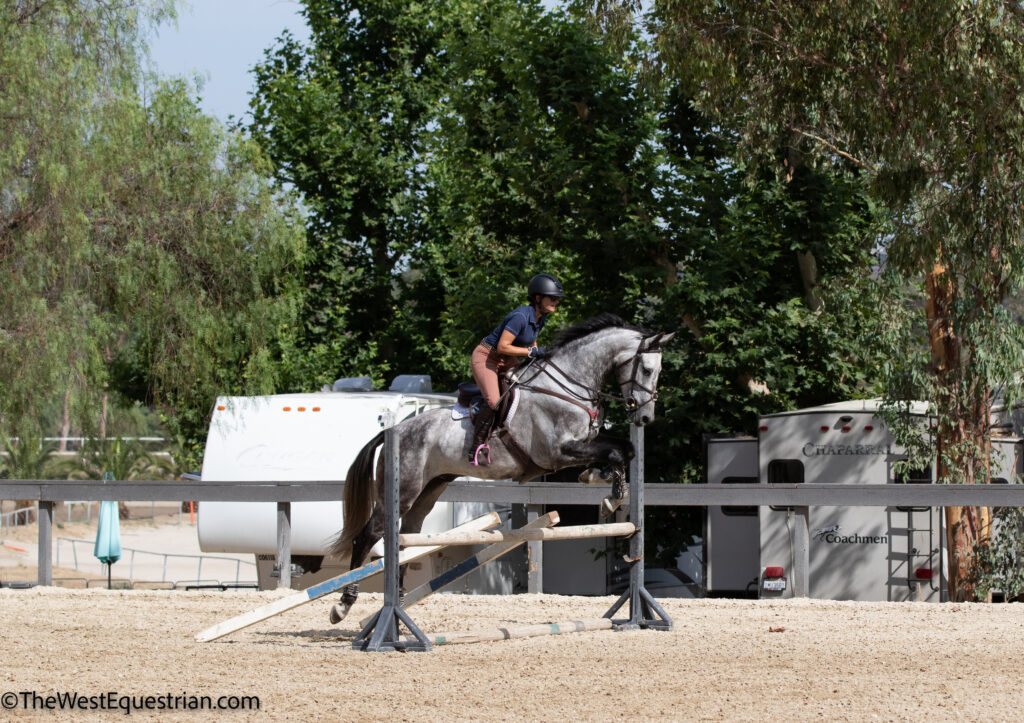
Create an Approach Canter
Junior rider Rachel Gilmore also had to override her instincts on approach to the jumps with her 8-year-old Holsteiner/Thoroughbred, CJ. CJ seemed most comfortable taking off from the base of the jump, so the goal was not to compound that by pulling on the reins coming to the jump.
The first step was developing an approach canter with some engagement and power—not speed—by balancing hand and leg aids. “If there’s hand, there must be leg,” Halliday stressed. “Have her in a great gear so that she arrives with some power underneath you.” The mare also tended to lean into her inside shoulder around turns and when taking off over the jump. Getting better engagement in the canter helped to prevent that, too.
Next, Gilmore had to go against her instinct. “Force yourself to give rein when you want to pull,” Halliday said. “The moment you want to say ‘whoa,’ instead, soften the rein and keep the leg on.” Doing so from the “good gear” approach canter made for a smoother jump and a landing from which they could move on down the line to the next fence, or smoothly through the turn for the next segment of the course.
By making these changes, Gilmore and CJ started Halliday’s course with five strides in an opening line where they’d needed six strides in the warm-up. CJ’s stride was more open and ground covering, and Gilmore’s rein pressure was supporting without breaking her momentum. “Check in with your rein regularly, instead of a sudden pull that blocks her.” Between fences, Halliday wanted Gilmore in a two point with her legs wrapped down and around the mare, while her upper body was strong and upright.
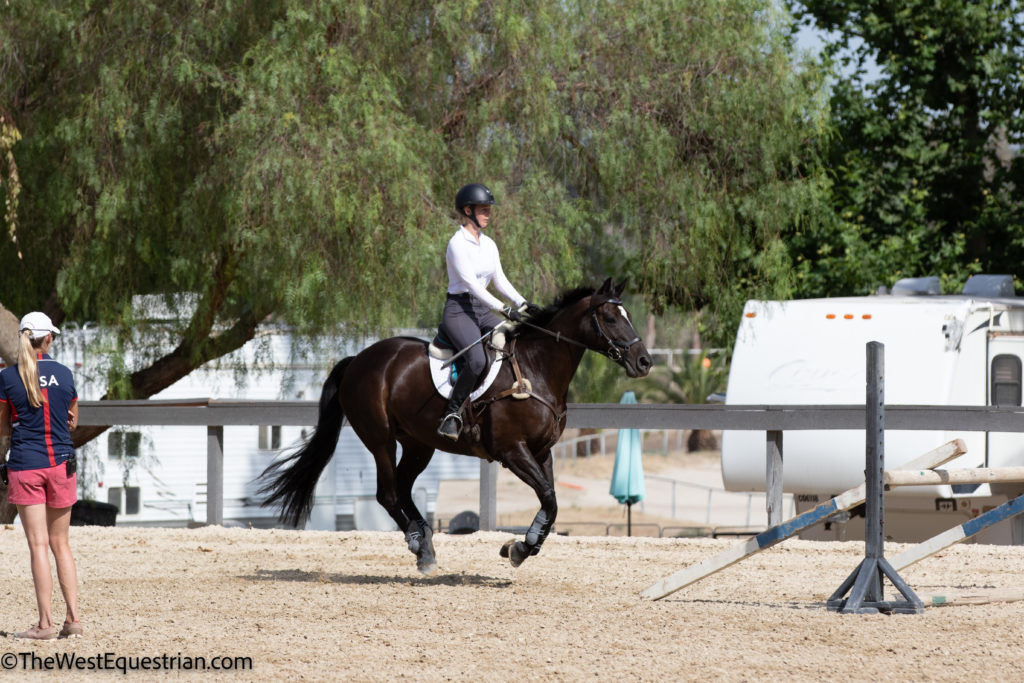
Cross-Country: Use More Leg
Amateur rider Kjersti Horais was looking to refine her first year at Preliminary after three years at Training with Grand Coeur. Toward that end, Horais wanted to focus on challenging cross-country questions and address her horse’s habitual left drift. Their work began in the warm-up with the now familiar refrain of “power, not speed.” They started with transitions on a big circle to help Horais get “Corey” in front of her leg and engaged. She needed to anticipate and counter the left drift by getting Corey to move off her left leg on the flat and not letting him collapse in to the left while circling in that direction.
Connection built in the arena is critical to success on cross-country, Halliday emphasized. “You want to feel like his hind legs are taking you somewhere and that you are riding into a feel.”
To get more reaction to her leg, Horais needed to wrap her leg down and around her big horse. Where she reinforced that with medium taps of the whip, Halliday advised a big kick instead and immediate praise for the horse when he spurted forward in response.
As they warmed-up over fences, Horais’ strong leg needed to be supported with an upright body position. Halliday’s rule is that her torso should never tip forward until the horse’s front legs have left the ground.

With their engine revved up, the pair moved on to their designated challenge: a vertical set in the water, then a slight right turn to a skinny arrow fence a few strides away atop a small bank. To establish the right power and energy, Halliday coached a tap behind the girth at take-off and spur on landing over a stand-alone rolltop fence 50 yards or so before the water obstacle.
While they’d been worried about Corey’s left drift, he actually ran out to the right in an early pass through the combination. Some uncharacteristic stops followed in subsequent efforts. Halliday encouraged Horais to maintain a strong leg and solid core position on approach, acknowledging that it was tough to do the more tired Horais became. “When you get tired, you are collapsing your upper body and throwing the reins at him at the last minute,” she noted. “When you fixed your body position, you could fight your way through it and end on a strong positive note,” Halliday praised when they came out of the water a few times and sailed over the skinny.
Horais’ homework was “way more leg in order to become confident” at the tougher challenges at Preliminary. “You’ll think you have your leg on him, but it’s not enough,” Halliday said. In addition, she must have constant vigilance about the power and engagement in his cross-country gallop. “Every three strides you should be checking for that.”
Watch Liz Halliday
Visit PracticaHorsemanOnDemand.com to watch videos from Liz Halliday’s clinic. Sign up for a 10-day free trail with subscription.
This article originally appeared in the Winter 2021 issue of Practical Horseman.






